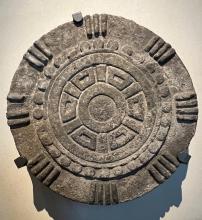tianquiztli (Mdz58r)
This example of a market (which we are labeling here as a tianquiztli, despite not having a gloss in Nahuatl) is pulled from the iconography of the Codex Mendoza. It is included here as a comparison for other examples of the tianquiztli (now called tianguis in Mexican Spanish). This one has concentric circles with hash marks around the outer edge, which may suggest a wall or some other type of construction, such as we see in the perimeter of some apantli (canal, waterway) examples. One of the inner circles also contains small concentric circles of the type that are seen below the roof of the tecpan (ruler's palace). The inner circle, colored a purplish-gray, has a light texturing.
Stephanie Wood
Markets or marketplaces were nearly synonymous with central squares or plazas in other cultures, but in Mesoamerica they also had judges or other officers present to ensure the smooth and fair operation of transactions. Sahagún also observed (see the quote in our Online Nahuatl Dictionary) how the tlahtoani, ruler, would take care of the marketplace.
The design of the glyph for the tianquiztli is round, with concentric circles. Berdan and Anawalt mention a "round, altarlike stone" that was placed in the center of the market, and this glyph recalls that marker (Codex Mendoza, 1992, vol. 2, 156). The name for the round, sculpted stone was momoztli, and these sacred stones could also be found elsewhere. Some of the monoliths—and parts of them—still exist today. See Leonardo López Luján and Bertina Olmedo, "Los monolitos del mercado y el glifo tianquiztli," Arqueología Mexicana 101 (2010), pp. 19–20, at this website.
In place of the sand (which could easily be a reference to the ground inside the market) in the glyph for Tianquizco (below, right), this glyph for tianquiztli from folio 58 recto of the Codex Mendoza has the inner ring with the circles painted red (a color that is often found on architecture). The purplish-gray color in the center of this market example is the same color used for glyphs of tlalli (earth, dirt, land). The tianquiztli glyphs in the Matrícula de Huexotzinco (see one below) show a collection of footprints going every which way in the inner circle, capturing our imagination of the human activity so prevalent in markets.
In Nahua culture, the word tianquiztli was also applied to a constellation, which may have been owing to some coincidence of shape between the standard marketplace and the arrangement of the stars (citlalli) that made up the constellation.
Stephanie Wood
c. 1541, or by 1553 at the latest
market, markets, mercados, tianguis
tianquiztli. Referred to as the Disco de Chalco, the Museo Nacional de Antropología e Historia, Salón Mexica, identifies this carved stone as signifying a tianquiztli, or marketplace. According to the Museo, "stones like this were affixed on top of small platforms within the marketplace in the area consecrated to the [patron] deity of the merchants...." Photograph by Robert Haskett, 14 Februry 2023.
tianquiz(tli), marketplace, https://nahuatl.wired-humanities.org/content/tianquiztli
Codex Mendoza, folio 58 recto, https://digital.bodleian.ox.ac.uk/objects/2fea788e-2aa2-4f08-b6d9-648c00..., image 126 of 188.
Original manuscript is held by the Bodleian Libraries, University of Oxford, MS. Arch. Selden. A. 1; used here with the UK Creative Commons, “Attribution-NonCommercial-ShareAlike 3.0 License” (CC-BY-NC-SA 3.0)






